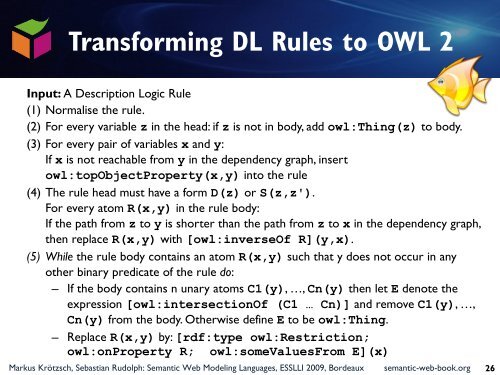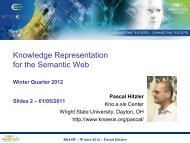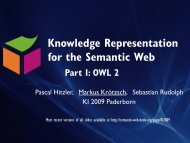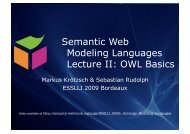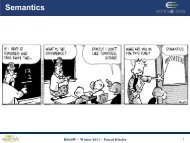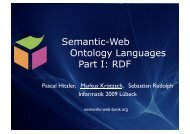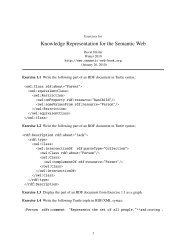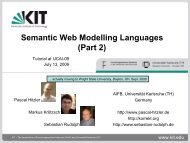Lecture 5 - Foundations of Semantic Web Technologies
Lecture 5 - Foundations of Semantic Web Technologies
Lecture 5 - Foundations of Semantic Web Technologies
You also want an ePaper? Increase the reach of your titles
YUMPU automatically turns print PDFs into web optimized ePapers that Google loves.
Transforming DL Rules to OWL 2<br />
Input: A Description Logic Rule<br />
(1) Normalise the rule.<br />
(2) For every variable z in the head: if z is not in body, add owl:Thing(z) to body.<br />
(3) For every pair <strong>of</strong> variables x and y:<br />
If x is not reachable from y in the dependency graph, insert<br />
owl:topObjectProperty(x,y) into the rule<br />
(4) The rule head must have a form D(z) or S(z,z').<br />
For every atom R(x,y) in the rule body:<br />
If the path from z to y is shorter than the path from z to x in the dependency graph,<br />
then replace R(x,y) with [owl:inverseOf R](y,x).<br />
(5) While the rule body contains an atom R(x,y) such that y does not occur in any<br />
other binary predicate <strong>of</strong> the rule do:<br />
– If the body contains n unary atoms C1(y), …, Cn(y) then let E denote the<br />
expression [owl:intersectionOf (C1 … Cn)] and remove C1(y), …,<br />
Cn(y) from the body. Otherwise define E to be owl:Thing.<br />
– Replace R(x,y) by: [rdf:type owl:Restriction;<br />
owl:onProperty R; owl:someValuesFrom E](x)<br />
Markus Krötzsch, Sebastian Rudolph: <strong>Semantic</strong> <strong>Web</strong> Modeling Languages, ESSLLI 2009, Bordeaux<br />
semantic-web-book.org<br />
26


